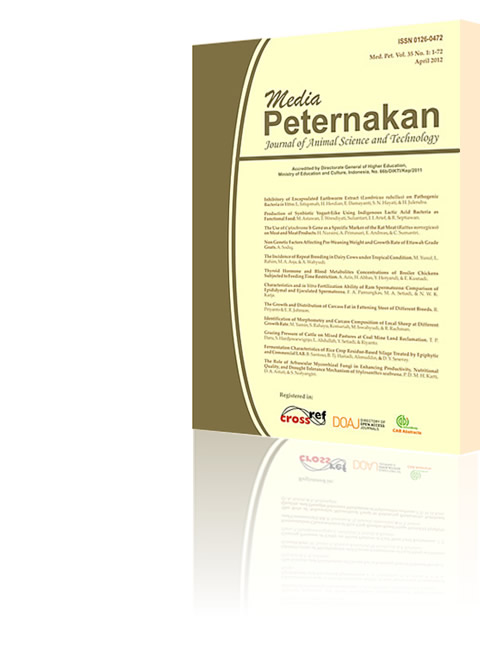-
B Santoso
-
B Tj Hariadi
-
. Alimuddin
-
D Y Seseray
Keywords:
silage, rice crop residue, lactic acid bacteria, digestibility
Abstract
Two experiments were conducted to investigate the effects of addition of lactic acid bacteria (LAB) inoculant from king grass and a commercial inoculant of L. plantarum on fermentation characteristics and nutrient digestibility of rice crop residue-based silage. In experiment 1, mixture of rice crop residue (RC), soybean curd residue (SC) and cassava waste (CW) in a 80 : 10 : 10 (on dry matter basis) ratio was used as silage material. Four treatments silage were (A) RC + SC + CW as a control; (B) RC + SC + CW + LAB inoculant from king grass (2%, v/w) ; (C) RC + SC + CW + LAB inoculant from king grass (3%, v/w); (D) RC + SC + CW + L. plantarum inoculant (2%, v/w). In experiment 2, six Kacang goats were used in a 6 × 3 Youden square experiment and fed elephant grass, rice straw, and rice crop residue-based silage. The results showed that crude protein (CP) content in silages B, C, and D was slightly higher than silage A. Lactic acid concentration was significantly higher (PL. plantarum inoculant.
Downloads
Download data is not yet available.
Author Biographies
B Santoso
Department of Animal Nutrition, Faculty of Animal Science, Fishery and Marine Science, State University of Papua
B Tj Hariadi
Department of Animal Nutrition, Faculty of Animal Science, Fishery and Marine Science, State University of Papua
. Alimuddin
Papua Barat Assessment Institute for Agricultural Technology, Manokwari
D Y Seseray
Department of Animal Production, Faculty of Animal Science, Fishery and Marine Science, State University of Papua
Jln. Gunung Salju, Amban, Manokwari-Papua Barat, Indonesia
Authors submitting manuscripts should understand and agree that copyright of manuscripts published are held by Media Peternakan. The statement to release the copyright to Media Peternakan is stated in Form A. This work is licensed under a Creative Commons Attribution-ShareAlike 4.0 International License (CC BY-SA) where Authors and Readers can copy and redistribute the material in any medium or format, as well as remix, transform, and build upon the material for any purpose, but they must give appropriate credit (cite to the article or content), provide a link to the license, and indicate if changes were made. If you remix, transform, or build upon the material, you must distribute your contributions under the same license as the original.



